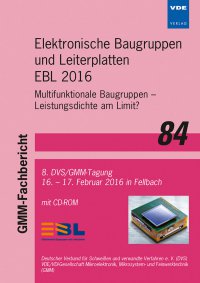A Product Based Reliability Analysis with a Focus on Lead-Free Solder Joints
Konferenz: Elektronische Baugruppen und Leiterplatten – EBL 2016 - 8. DVS/GMM-Tagung
16.02.2016 - 17.02.2016 in Fellbach, Deutschland
Tagungsband: Elektronische Baugruppen und Leiterplatten – EBL 2016
Seiten: 5Sprache: EnglischTyp: PDF
Persönliche VDE-Mitglieder erhalten auf diesen Artikel 10% Rabatt
Autoren:
Youssef, Abdalla (BMW Group, Munich Technische Universität Berlin, Forschungsschwerpunkt Technologien der Mikroperipherik, Berlin, Germany)
Birner, Ingo; Vodiunig, Robert; Voelkel, Holger (BMW Group, Munich, Germany)
Middendorf, Andreas; Hutter, Matthias; Lang, Klaus-Dieter (Technische Universität Berlin, Forschungsschwerpunkt Technologien der Mikroperipherik, Berlin, Germany)
Inhalt:
Electronic control units (ECUs) in automotive industry are embedded micro-electronic systems controlling a system or a sub-system in a motor vehicle. These systems are exposed to extreme harsh electrical and physical working conditions. Moreover, due to the continuous innovation in automotive industry, complexity and miniaturization of these systems are increasing. Consequently, the reliability of these systems is a very important topic for OEM’s. Reliability as a definition is the ability of the device to perform its designed function in terms of years of useful lifetime. One of the governing factors determining the reliability of electronic control units are first level interconnect technologies; solder joints between electronic components and the printed circuit board. Accelerated testing experiments are used to obtain reliability information by visualizing the possible failure mechanisms during the useful lifetime relatively quick compared to the actual useful lifetime. Systems are subjected to more severe stress levels than those specified in the normal operating conditions. Interfacial structure of solder joints is a main factor determining solder joint reliability. The concerns are not only void formation between the solder and copper substrate, however, formation and growth of intermetallic compounds (IMCs) is a concern as well. These compounds are brittle materials in nature which could crack and fracture when subjected to mechanical or thermo-mechanical loading leading to possible electrical or overheating failures. In order to understand the governing factors determining the reliability of electronic control units under environmental loading conditions, a comprehensive design of experiment has been prepared using commercial electronic modules out of production line. The modules have been stressed in active mode using different designed stress conditions; single and combined loading conditions in order to realize the possible field conditions. Sequential failure analysis follows the aging process including functional testing, visual and optical inspection, metallography and microscopy investigations. Evolution of the interfacial structure as well as the mechanical reliability of the solder joints under the different stressing conditions is discussed. To the author’s best knowledge; it is the first time to design and perform aging tests directly on commercial electronic modules with optimized reliability level from the production line. Based on the observations obtained from this study, a deep understanding of the aging mechanisms under different environmental stress conditions has been reached. Consequently, it has been concluded that solder joint failure mechanisms are more dominant than failure mechanisms of other components. IMCs growth, voiding and cracking in the solder joints resulting from the designed stressing conditions is observed. These aging mechanisms lead to malfunctioning due to electrical failures or overheating. Future work is then proposed in order to verify the reached conclusions.


